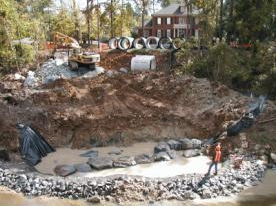Recently, the Charlotte-Mecklenburg area’s growth rate has exponentially increased. This is a subject that has received a substantial amount of focus due to the environmental stressing factors that rapid human expansion brings, but lately the main topic of focus concerning this unyielding growth rate has been how to restructure and reshape Charlotte water management. Until about a decade ago, Charlotte-Mecklenburg water management planning had followed traditional American water basin and river management protocols that had been set in place for nearly half a century. Yet, after the 2000 census, hydrologists, environmentalists, and politicians alike realized that the current water management administration could no longer adequately support the projected population in the Charlotte area within 50 years. Subsequently, the Charlotte-Mecklenburg Master Water Plan was conceived in the early 2000’s and still undergoes adjustments to this day. The plan calls for restructuring of storm water collection and transporting systems, as well as new measures for water quality testing, and waste water treatment in Charlotte and its surrounding suburbs, including Davidson, North Carolina. The new system plans to replace and refine any and all breaks, leaks, and dilapidated piping or water transporting systems over the 8,000 miles of piping managed by the city utility services. Additionally, the city plans to partner with Duke Energy to begin regulating withdraws and dumping in the Catawba River. However, perhaps one of the most significant factors deals with improvements in storm water collection, retention, and treatment. This new plan takes into account impermeable surface restrictions and regulations, tertiary treatment options for storm water at “vulnerable” locations, and making sure a decent amount of storm water is returned/discharged into either the Lake Norman basin or the Catawba River for possible further utility use if needed. With all these new protocols taking gradual effect, the master plan has now increased the Charlotte-Mecklenburg’s water resource shelf life from just 50 years to nearly 150-200 years thanks to the new system’s efficiency. Thanks to effective managers and brilliant hydrologists, plans such as these can hopefully be adopted across the nation. Collaborative water management is the most effective water management, and in this case is the most secure way towards a healthy future not just for the Catawba River, but for Charlotte’s water resources in general.
(Storm-water Retention Project)
(Areas of Special Focus in New Plan for Mecklenburg County)



